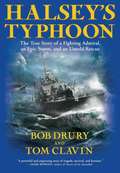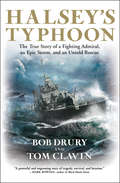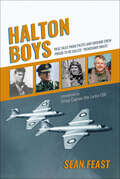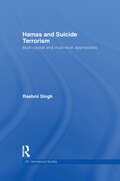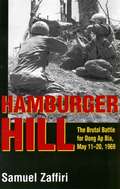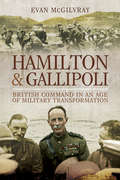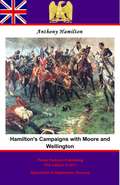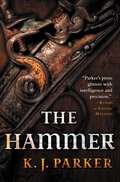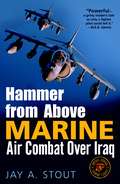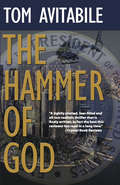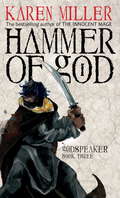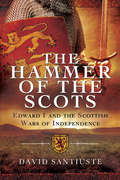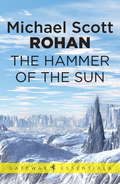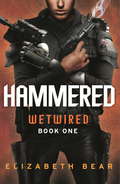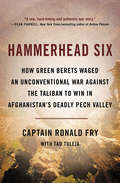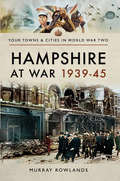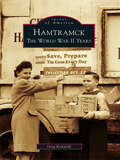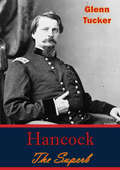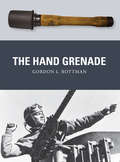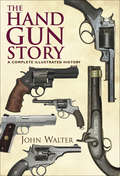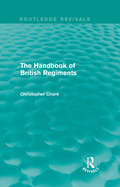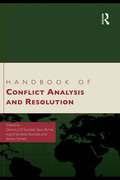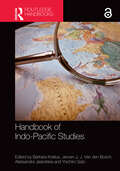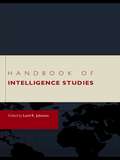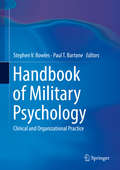- Table View
- List View
Halsey's Typhoon: The True Story of a Fighting Admiral, an Epic Storm, and an Untold Rescue
by Tom Clavin Bob DruryIn the tradition of The Perfect Storm and Flags of Our Fathers , Halsey’s Typhoon chronicles the epic tale of men clashing against the ruthless forces of war and nature. In December 1944, America’s most popular and colorful naval hero, Admiral William “Bull” Halsey, unwittingly sailed his undefeated Pacific Fleet into the teeth of the most powerful storm on earth. Three destroyers were capsized sending hundreds of sailors and officers into the raging, shark infested waters. Over the next sixty hours, small bands of survivors fought seventy-foot waves, exhaustion, and dehydration to await rescue at the hands of the courageous Lt. Com. Henry Lee Plage, who, defying orders, sailed his tiny destroyer escort USS Tabberer through 150 mph winds to reach the lost men. Thanks to documents that have been declassified after sixty years and dozens of first-hand accounts from survivors—including former President Gerald Ford—one of the greatest World War II stories, and a riveting tale of survival at sea, can finally be told. Image descriptions added.
Halsey's Typhoon: The True Story of a Fighting Admiral, an Epic Storm, and an Untold Rescue
by Bob Drury Tom ClavinThis account of a disaster at sea during World War II is “a powerful and engrossing story of tragedy, survival, and heroism” (Mark Bowden, author of Black Hawk Down). In the final days of 1944, Admiral William “Bull” Halsey is the Pacific theater’s most popular and colorful naval hero. After a string of victories, the “Fighting Admiral” and his thirty-thousand-man Third Fleet are charged with protecting General MacArthur’s flank during the invasion of the Philippine island of Mindoro. But in the midst of the landings, Halsey attempts a complicated refueling maneuver—and unwittingly drives his 170 ships into the teeth of a massive typhoon. Halsey’s men find themselves battling ninety-foot waves and 150 mph winds. Amid the chaos, three ships are sunk and nearly nine hundred sailors and officers are swept into the Philippine Sea. For three days, small bands of survivors battle dehydration, exhaustion, sharks, and the elements, awaiting rescue. It will be up to courageous lieutenant commander Henry Lee Plage to defy orders and sail his tiny destroyer escort, the USS Tabberer, back into the storm to rescue drifting sailors. Revealing a little-known chapter of WWII history in absorbing detail, this is “a vivid tale of tragedy and gallantry at sea.” (Publishers Weekly).
Halton Boys: True Tales from Pilots and Ground Crew Proud to be Called 'Trenchard Brats'
by Sean FeastA history of the twentieth-century Royal Air Force training programme as told by the men who lived it.The RAF Halton Apprenticeship Scheme has a deserved reputation for excellence. The brainchild of MRAF Hugh Trenchard, the founder of the Royal Air Force, it took the “traditional” idea of an apprenticeship and interpreted it in a novel way. It allowed teenage boys from any social background or geography to learn a technical trade that would equip them for their future lives, within and beyond the RAF. It also gave the best an opportunity to become pilots and break into the once public-school-dominated officer class. Of the 50,000 boys trained as apprentices, seventeen won the Sword of Honour at Cranwell, and more than 1,200 were commissioned with 110 achieving Air Rank. Eighteen have been knighted, with well over 1,000 others being honoured at various levels of state.More than a hundred Halton Boys served as pilots in the Battle of Britain (and many more as airframe/engine fitters and armourers), including former Olympic hurdler Don Finlay. Others like Gerry Blacklock and Pat Connolly flew bombers on perilous missions over Western Europe or took part in the famous “Dams” Raid. Then there were the three men murdered for their part in the Great Escape, and those who battled and survived years as prisoners of the Japanese in the Far East.In the jet era, ex-apprentice Graham Hulse became an “ace” in Korea, serving with an American fighter squadron, and Mike Hines went on to become OC 617 Squadron after having first flown operations during the Suez crisis. Others like Charles Owen became a pioneer commercial jet pilot, and Peter Goodwin had the misfortune of being captured in the first Gulf War and used as a human shield.Some forged successful careers beyond the RAF, like Lawrie Haynes, who was on the main board at Rolls-Royce and is now chairman of the Board of Trustees of the Royal Air Force Benevolent Fund, and Eugene Borysuik—one of the many Polish apprentices trained at Halton, who enjoyed a successful career at GEC. And there were many others beyond air and ground crew including policemen, government officials and even bishops whose careers started with the Halton family.This is the story of Halton told through and by the boys who were there and who are still proud to be called “Trenchard Brats.”
Hamas and Suicide Terrorism: Multi-causal and Multi-level Approaches (LSE International Studies Series)
by Rashmi SinghThis book analyses the root causes of suicide terrorism at both the elite and rank-and- file levels of the Hamas and also explains why this tactic has disappeared in the post-2006 period. This volume adopts a multi-causal, multi-level approach to analyse the use of suicide bombings by Hamas and its individual operatives in the Israeli-Palestinian conflict. It uses extensive fieldwork and on-the-ground interviews in order to delve beneath the surface and understand why and how suicide operations were adopted as a sustained mechanism of engagement within the Israeli-Palestinian conflict. Three core factors fuelled Hamas’s suicide bombing campaigns. First, Palestinian suicide operations are a complex combination of instrumental and expressive violence adopted by both organisations and individuals to achieve political and/or societal survival, retaliation and competition. In other words, suicide bombings not only serve distinct political and strategic goals for both Hamas and its operatives but they also serve to convey a symbolic message to various audiences, within Israel, the Palestinian territories and around the world. Second, suicide operations perform a crucial role in the formation and consolidation of Palestinian national identity and are also the latest manifestation of the historically entrenched cultural norm of militant heroic martyrdom. Finally, Hamas’s use of political Islam also facilitates the articulation, justification and legitimisation of suicide operations as a modern-day jihad against Israel through the means of modern interpretations and fatwas. This approach not only facilitates a much needed, multifaceted, holistic understanding of suicide bombings in this particular region but also yields policy-relevant lessons to address extreme political violence in other parts of the world. This book will be of much interest to students of Hamas, terrorism, Middle East politics and security studies.
Hamburger Hill: The Brutal Battle for Dong Ap Bia: May 11-20, 1969
by Samuel ZaffiriThe battle for Ap Bia Mountain (Hill 937), was one of the fiercest of the entire Vietnam War.
Hamilton & Gallipoli: British Command in an Age of Military Transformation
by Evan McGilvrayThis is a study of Sir Ian Hamilton VCs command of the Gallipoli campaign. Appointed by Kitchener after the failure of the initial Allied naval offensive in the Dardanelles, Hamilton was to lead the ambitious amphibious landings that were intended to open the way to Constantinople. In the event, however, opportunities immediately after the landings were squandered and, in the face of unexpectedly effective Turkish resistance, soon stalled in attritional trench warfare like that on the Western Front. Hamilton has often been criticized for this failure and in many ways seen to typify the stereotype of a British general clinging to outdated Victorian thinking. Yet this fresh reappraisal, drawing on original archival research, shows that Hamilton did display some progressive ideas and a realization that warfare was rapidly changing. Like all generals of this period he faced the challenge of unprecedented technological and tactical revolution as well as the political and media battle. It is as a case study of command in these circumstances that Evan Mcgilvray's assessment of Hamilton will be most valued.
Hamilton's Campaigns with Moore and Wellington during the Peninsular War: Original And Compiled (classic Reprint)
by Anthony HamiltonThis ebook is purpose built and is proof-read and re-type set from the original to provide an outstanding experience of reflowing text for an ebook reader. The memoir of another of the hardy and eloquent Irish soldiers that fought in the British army during the Peninsular Wars. Hamilton's memoirs were not intended for a large publication and do not contain the details of camp and campaign life that you might find in such works by Costello, Tomkinson or Kincaid. They are, however, a collection of first rate eye-witness accounts of the battles that Hamilton and his comrades of the 43rd regiment of Foot took part in, or was in a position to offer a close second-hand account of. The list of battles covered encompasses almost all of the major engagements that the British army took part in the Peninsular and 1815 campaign; Rolica, Vimiero, Coruña, Talavera, Busaco, Albuera, Fuentes d'Oñoro, the sieges of Cuidad Rodrigo and Badajoz, Salamanca, Vittoria and finally Waterloo. A pithy eye-witness account. Author - Anthony Hamilton - (1779 - 1844) Text taken, whole and complete, from the edition published in 1847, New York, by Prescott and Wilson Original - 163 pages. TOC included
The Hammer
by K. J. ParkerGignomai is the youngest brother in the current generation of met'Oc, a once-noble family exiled on an island for their role in a vaguely remembered civil war. On this island, a colony was founded seventy years ago. The plan was originally for the colonists to mine silver, but there turned out not to be any. Now, an uneasy peace exists on the island, between the colonists and the met'Oc. The met'Oc are tolerated, in spite of occasional cattle stealing raids, since they alone possess the weapons considered necessary protection against the island's savages. Gignomai is about to discover exactly what it is expected of him, and what it means to defy his family. He is the hammer who will provide the spark that will ignite a brutal and bloody war.
Hammer from Above: Marine Air Combat Over Iraq
by Jay A. StoutIn Operation Iraqi Freedom, the Marine Corps' ground campaign up the Tigris and Euphrates was notable for speed and aggressiveness unparalleled in military history. Little has been written, however, of the air support that guaranteed the drive's success. Paving the way for the rush to Baghdad was "the hammer from above"-in the form of attack helicopters, jet fighters, transport, and other support aircraft. Now a former Marine fighter pilot shares the gripping never-before-told stories of the Marines who helped bring to an end the regime of Saddam Hussein. As Jay Stout reveals, the air war had actually been in the planning stages ever since the victory of Operation Desert Storm, twelve years earlier. But when Operation Iraqi Freedom officially commenced on March 20, 2003, the Marine Corps entered the fight with an aviation arm at its smallest since before World War II. Still, with the motto "Speed Equals Success," the separate air and ground units acted as a team to get the job done. Drawing on exclusive interviews with the men and women who flew the harrowing missions, Hammer from Above reveals how pilots and their machines were tested to the limits of endurance, venturing well beyond what they were trained and designed to do. Stout takes us into the cockpits, revealing what it was like to fly these intense combat operations for up to eighteen hours at a time and to face incredible volumes of fire that literally shredded aircraft in midair during battles like that over An Nasiriyah . With its dynamic descriptions of perilous flights and bombing runs, Hammer from Above is a worthy tribute to the men and women who flew and maintained the aircraft that so inspired their brothers in arms and terrified the enemy. From the Hardcover edition.
The Hammer of God: Quarterback Operations Group Book 2 (Quarterback Operations Group #2)
by Tom AvitabileA team from a top-secret government agency must track down a nuclear bomb in this political suspense thriller for fans of Robert Ludlum and Clive Cussler. With America in the crosshairs of criminals who don&’t have to play by the rules, President James Mitchell needed an edge. That&’s where Bill Hiccock&’s Quarterback Ops Group, (QuOG) a top-secret operations cluster run out of the White House, comes in. Given unprecedented power, these dedicated men and women cut through the cells and terror networks at home and abroad, unleashing the full force and determination of America across the world. From psych-ops, where they terrorize the terrorists, to the pure brute force of going in hot, wet, and wild, QuOG uses innovative technology and on-the-spot improvisation to beat the bad guys before they know the game is on. Hiccock fields his handpicked team of the &“best of the best&” in abilities and prowess: people like Brooke Burrell, who distinguished herself as an FBI agent, and now goes toe to toe with a terrorist mastermind; Bridgestone and Ross who cut through countries, culture, and killers like a laser through butter; former hacker for the mob, Kronos, who practically mind-melds with any computer, network, or Internet backbone and manipulates it to do his bidding; Janice Hiccock, Bill&’s brilliant wife, who provides insight into the human behavior; and Bill himself, whose keen analytical mind and propensity to somehow find himself in the line of fire befits an academic titan . . .who also happened to have won the Heisman Trophy. Their current goal: find a loose suitcase nuke before it finds its way to a city near you and ends millions of lives.
Hammer of God: Godspeaker: Book Three (Godspeaker #3)
by Karen Miller'A writer who seems to set the rule for the genre' - WATERSTONE'S BOOKS QUARTERLY'Top-notch fantasy . . . a masterclass writer' - SFFWORLDIn Ethrea, Rhian sits upon a precarious throne. Defiant noblemen who won't accept her rule threaten the stability of her kingdom, Zandakar, a man she thought was her friend, has been revealed as the son of a woman sworn to destroy her and her husband, King Alasdair, is increasingly unsure of her love.Rhian's most grave problem, however, lay outside the borders of her realm. The trading nations refuse to believe Mijak is a threat and promise reprisals if she dares to protect her realm. If she cannot unite the warring factions within her land, a move again Mijak might prove the end of her reign. Which is exactly what the empress of Mijak has planned. . .The third volume of Karen Miller's epic fantasy of power, politics and the rise and fall of empires . . .Books by Karen Miller:Kingmaker, Kingbreaker SeriesThe Innocent MageThe Awakened MageA Blight of MagesGodspeakerEmpress of MijakThe Riven KingdomFisherman's ChildrenThe Prodigal MageThe Reluctant MageTarnished CrownThe Falcon ThronePrince of Glass
The Hammer of the Scots: Edward I and the Scottish Wars of Independence
by David SantiusteKnown to posterity as Scottorum Malleus - the Hammer of the Scots - Edward I was one of medieval England's most formidable rulers. In this meticulously researched new history, David Santiuste offers a fresh interpretation of Edward's military career, with a particular focus on his Scottish wars. This is in part a study of personality: Edward was a remarkable man. His struggles with tenacious opponents - including Robert the Bruce and William Wallace - have become the stuff of legend.There is a clear and perceptive account of important military events, notably the Battle of Falkirk, but the narrative also encompasses the wider impact of Edward's campaigns. He attempted to mobilize resources - including men, money and supplies - on an unprecedented scale. His wars affected people at all levels of society, throughout the British Isles.David Santiuste builds up a vivid and convincing description of Edward's campaigns in Scotland, whilst also exploring the political background. Edward emerges as a man of great conviction, who sought to bend Scotland to his will, yet also, on occasion, as a surprisingly beleaguered figure. He is presented here as the central character in a turbulent world, as commander and king.
The Hammer of the Sun (Gateway Essentials #312)
by Michael Scott RohanIn the great battle which had returned control of Morvannec, the legendary city, to mankind, Elof the Smith had saved Kara, his love, from the immortal Power which ruled her. But in the seven years since, the Smith has grown fearful that Kara, herself no mortal, will one day leave him. In his fear, Elof makes the mistake of drawing on his own uncanny powers to bind Kara closer to him; he only succeeds in driving her away. Haunted, guilt-ridden, Elof can do nothing but follow his love eastwards, across the Seas of Sunrise, towards the city of Kerys in which Kermorvan of Kerbryhaine's people had originated. In the myth-filled lands of the East, where the Powers of the Ice contemplate the total extinction of life, Elof must face his past, his future and his destiny.
Hammered: Book One (Jenny Casey)
by Elizabeth BearFrom Elizabeth Bear comes a near-future tale about a woman who was engineered for combat in a world that's running out of time.Jenny Casey is a former Canadian special forces warrior living on the hellish streets of Hartford, Connecticut, in the year 2062. Her artificially reconstructed body is failing her, but a government scientist from her old life thinks she is perfect for his high-stakes project.Suddenly Jenny is a pawn in a battle being waged on the Internet, the streets, and in the complex wirings of her man-made nervous system. And she needs to gain control of the game before a brave new future spins completely out of control.
Hammerhead Six: How Green Berets Waged an Unconventional War Against the Taliban to Win in Afghanistan's Deadly Pech Valley
by Tad Tuleja Ronald FryTwo years before the action in Lone Survivor, a team of Green Berets conducted a very different, successful mission in Afghanistan's notorious Pech Valley. Led by Captain Ronald Fry, Hammerhead Six applied the principles of unconventional warfare to "win hearts and minds" and fight against the terrorist insurgency. In 2003, the Special Forces soldiers entered an area later called "the most dangerous place in Afghanistan." Here, where the line between civilians and armed zealots was indistinct, they illustrated the Afghan proverb: "I destroy my enemy by making him my friend." Fry recounts how they were seen as welcome guests rather than invaders. Soon after their deployment ended, the Pech Valley reverted to turmoil. Their success was never replicated. Hammerhead Six finally reveals how cultural respect, hard work (and the occasional machine-gun burst) were more than a match for the Taliban and Al Qaeda.
Hampshire at War, 1939–45 (Your Towns & Cities in World War Two)
by Murray RowlandsHampshire at War 1939-45 looks at the pivotal role Hampshire played during the Second World War, including principal details of the genesis for D-Day and how the Battle for Britain happened on a day by day basis. The author highlights the peoples experience of total war from the blitz in Portsmouth, Gosport and Southampton, along with raids throughout the county, not to mention the role played by the Royal Navy at sea and in the dockyards. As well as saluting the role of civilians who created and built Spitfires and Hurricanes, the book places a rightful spotlight on the role Hampshire's women played in the final victory.Hampshires major effort towards final victory arose from the towns and hamlets of the county. Training for the secret war and espionage took place in Beaulieu and the training for the Cockleshell Heroes took place around Southsea. Hampshires war involved the arrival of men and women from all over the world, but in particular from Canada and America with important cultural changes for everyone living there. When invasion threatened in 1940, a defence of Britain had to be organised and Hampshire's coast was particularly vulnerable. Details of how German troops would be resisted after landings in the Solent and along Hampshires coast are also explored.Hampshire at War 1939 - 1945 traces the progress of evacuating its children from vulnerable cities such as Southampton and Portsmouth, and records the experiences of the children themselves. But most importantly, Murray Rowlands provides the experience of living through the Second World War, as it happened.
Hamtramck: The World War II Years (Images of America)
by Greg KowalskiWith a population made up overwhelmingly of Polish immigrants and descendents of Poles, Hamtramck was especially hardhit by the impact of World War II. Most of the city's residents had family contacts with the old country. When Germany invaded Poland on September 1, 1939, Hamtramckans reacted with shock and anger--and with a determination to see fascism defeated and Poland freed. Thousands of Hamtramckans fought in the war, hundreds died. And those who remained at home dealt with the wartime life as best they could. Hamtramck: The World War II Years presents a portrait of the city at war. It tells and shows how Hamtramckans--of all ages, races, and backgrounds--coped with shortages, the threat of attack, and the everpresent dread that the next telegram may bring news of a soldier's death. It was a challenging time that demanded strength, dedication, and sacrifice. Hamtramckans stood up and delivered all that was required--and more.
Hancock The Superb
by Glenn TuckerThis is the life story of a great fighting general of the Civil War, Winfield Scott Hancock. In the early fighting on the Peninsula, when the Confederates were flanked out of Fort Magruder, McClellan reported, "Hancock was superb." Before long people were referring to him as Hancock the Superb, and for the next three years he re-earned the sobriquet in battle after battle. He was able to distinguish himself equally in disastrous defeat, as at Chancellorsville, and m victory, as at Gettysburg. Tucker feels personally that some of Hancock's work with Grant--in the Wilderness and at Spotsylvania--was the most fascinating of his career, and he makes a good case for this view.Glenn Tucker chose to write about Hancock primarily because of his interesting personality and remarkable career. These are reason enough.He also had another reason. For more than three years, while a succession of commanding generals came and went, Hancock was a growing power in the Army of the Potomac. Along with his study of Hancock, Tucker also presents a graphic picture of the Army of the Potomac.It was a much maligned army. Because of its inept, bumbling commanders, it took some crushing and much publicized defeats. But in spite of Pope, Burnside, Hooker and others not much better, it weathered the worst blows Lee could inflict on it, preserved a bloody stalemate and at last wore down the enemy.Hancock and the Army of the Potomac fought together right up to the end. Never seeking top command, Hancock was the best and most trusted of the subordinate generals. Under good commanders and bad, his steadiness, unfailing courage and incisive military judgment many times helped to preserve the Army of the Potomac as an efficient fighting force.Glenn Tucker's reporting skill puts you right in the action. You are at Hancock's elbow in a score of battles in Virginia and you are there for three cataclysmic days at Gettysburg.
The Hand Grenade
by Gordon L. RottmanThe Hand Grenade is the dramatic story, covering its origins, development, use - in the World Wars and into the present day - and lasting influence on close-quarter combat and infantry tactics.Allowing the user to inflict damage on his opponent within throwing range without leaving cover, the portable, lethally efficient hand grenade is a ubiquitous weapon of modern warfare, and has now found its way into law-enforcement arsenals too. In this engaging study the origins, development, combat use and lasting legacy of the military hand grenade are explored and assessed, accompanied by specially commissioned full-color artwork and an array of revealing photographs of grenades in use and in close-up.
The Hand Gun Story: A Complete Illustrated History
by John WalterA firearms expert &“traces the history of the &‘one hand gun&’ from its 14th century origins . . . surveying changing technology, techniques, and design&” (Midwest Book Review). Ideally suited for both attack and self-defense, handguns have gotten smaller and deadlier. But the earliest pistols had a tendency to misfire. This was cured by the cap-lock, which proved a massive success in the American Civil War, with hundreds of thousands of cap-lock revolvers used on each side. Self-contained metal-case cartridges were to bring a fundamental change to handgun design: not only by allowing the introduction of revolvers that ejected automatically or were easily reloaded, but also by paving the way for the automatic pistol. World War I provided the handgun with a proving ground. At the end of the hostilities, with so much surplus weaponry, work on the handgun could have ceased; instead, a new developmental phase was begun by the nations that had emerged from the crumbling Imperial empires. During World War II, the efficiency of well-established designs was confirmed and new designs, such as the Walther P. 38, showed their potential. The emergence of the submachine-gun in 1945 reduced the status of the handgun—but only temporarily. The need for efficient self-defense shows no signs of lessening; and the rise in shooting for sport, particularly with the revolver, has sharpened the quest for efficiency. The never ending search for advanced production techniques shows that the handgun has as much a future in the twenty-first century as it had in the heyday of the Wild West, or in the trenches of Passchendaele.
The Handbook of British Regiments (Routledge Revivals)
by Christopher ChantSince the creation of the standing army in 1661, when each regiment was known by the name of its current colonel, there have been many reforms and rationalizations of the British army. From 31 cavalry regiments and 113 infantry regiments in 1881, at the time of this title’s first publication in 1988, the army had reduced to just 16 regiments of armour and 39 regiments of infantry through processes of absorption and amalgamation. The Handbook of British Regiments provides insight into the lineage and history of the approximately 85 regiments and corps which formed the British army towards the end of the 1980s. Comprehensive in coverage, each has a separate entry giving factual details in a layout standardized for easy comparison, including current title, colonel-in-chief, uniform and history, amongst others. A key title amongst Routledge reference reissues, this handbook provides an accessible guide to specialists as well as lay enthusiasts, and illustrates a sense of the continuity and inherited tradition of each regiment and corps.
Handbook of Conflict Analysis and Resolution
by Dennis J.D. Sandole Sean Byrne Ingrid Sandole-Staroste Jessica SenehiThis major Handbook comprises cutting-edge essays from leading scholars in the field of Conflict Analysis and Resolution (CAR). The volume provides a comprehensive overview of the core concepts, theories, approaches, processes, and intervention designs in the field. The central theme is the value of multidisciplinary approaches to the analysis and
Handbook of Indo-Pacific Studies (Indo-Pacific in Context)
by Barbara Kratiuk, Jeroen J. J. Van den Bosch, Aleksandra Jaskólska and Yoichiro SatoThis handbook explores the significance of the Indo-Pacific in world politics. It shows how the re-emergence of the Indo-Pacific in international relations has fundamentally changed the approach to politics, economics and security. The volume: explores the themes related to trade, politics and security for better understanding of the Indo-Pacific and the repercussions of the region's emergence studies different security and political issues in the region: military competition, maritime governance, strategic alliances and rivalries, and international conflicts analyses various socio-economic dimensions of the Indo-Pacific, such as political systems, cultural and religious contexts, and trade and financial systems examines the strategies of various states, such as the United States, Japan, India and China, and their approaches towards the Indo-Pacific covers the role of middle powers and small states in detail Interdisciplinary in approach and with essays from authors from around the world, this volume will be indispensable to scholars, researchers and students in the fields of international relations, politics and Asian studies.
Handbook of Intelligence Studies
by Loch K. JohnsonThis topical volume offers a comprehensive review of secret intelligence organizations and activities. Intelligence has been in the news consistently since 9/11 and the Iraqi WMD errors. Leading experts in the field approach the three major missions of intelligence: collection-and-analysis; covert action; and counterintelligence. Within each of these missions, the dynamically written essays dissect the so-called intelligence cycle to reveal the challenges of gathering and assessing information from around the world. Covert action, the most controversial intelligence activity, is explored, with special attention on the issue of military organizations moving into what was once primarily a civilian responsibility. The authors furthermore examine the problems that are associated with counterintelligence, protecting secrets from foreign spies and terrorist organizations, as well as the question of intelligence accountability, and how a nation can protect its citizens against the possible abuse of power by its own secret agencies. The Handbook of Intelligence Studies is a benchmark publication with major importance both for current research and for the future of the field. It is essential reading for advanced undergraduates, graduate students and scholars of intelligence studies, international security, strategic studies and political science in general.
Handbook of Military Psychology
by Stephen V. Bowles Paul T. BartoneThis expert compendium surveys the current state of military psychology across the branches of service at the clinical, research, consulting, and organizational levels. Its practical focus examines psychological adjustment pre- and post-deployment, commonly-encountered conditions (e. g. , substance abuse), and the promotion of well-being, sleep, mindfulness, and resilience training. Coverage pays particular attention to uses of psychology in selection and assessment of service personnel in specialized positions, and training concerns for clinicians and students choosing to work with the military community. Chapters also address topics of particular salience to a socially conscious military, including PTSD, sexual harassment and assault, women's and LGBT issues, suicide prevention, and professional ethics. Among the specific chapters topics covered: #65533; Military deployment psychology: psychologists in the forward environment. #65533; Stress and resilience in married military couples. #65533; Assessment and selection of high-risk operational personnel: processes,procedures, and underlying theoretical constructs. #65533; Understanding and addressing sexual harassment and sexual assault in the US military. #65533; Virtual reality applications for the assessment and treatment of PTSD. #65533; Plus international perspectives on military psychology from China, Australia, India, and more. Grounding its readers in up-to-date research and practice, Military Psychology will assist health psychologists, clinical psychologists, psychiatrists, and clinical social workers in understanding and providing treatment for military populations, veterans, and their families, as well as military psychologists in leadership and consulting positions.
